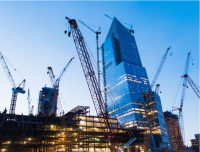
By Valentina Romeo, Investment Writer at Schroders
Europe’s energy security remains a key concern despite the progress the region has made in weaning itself off Russia’s gas imports. Throughout 2022 and 2023, European nations have significantly increased their reliance on alternative energy sources, reducing their dependence on Russian natural gas and swiftly replenishing their gas storage levels.
At the same time, relatively mild weather last winter meant demand for fossil fuels remained low, helping with the energy transition efforts in many countries.However, pressing questions remain on whether all these preparations will be sufficient to face the coming months. Will Europe be able to tackle the potential challenges that the energy market could pose in 2024 and beyond?
Who supplies Europe’s energy today?
After fears that Europe could run out of gas in 2022 after Russia cut gas exports following the start of the Ukraine conflict, its energy position has been looking much more stable. Norway has replaced Russia as the largest gas supplier, while a combination of mild winter temperatures, lower energy prices and the boost of liquified natural gas (LNG) imports from international suppliers ensured Europe survived the past winter and could plan ahead.
All these factors meant that gas storage facilities across the European continent were at 90% capacity in August, almost three months ahead of the 1 November deadline. Europe has also made bigger steps in its energy transition. As part of the gas demand reduction regulation established by the REPowerEU plan, consumption of gas dropped by over 19% (15% was the minimum requirement) between August 2022 and January 2023, compared with the same period five years before.
Karin Kaiser, Head of Private Markets Europe, Schroders Greencoat, said: “Gas storage levels are high going into the winter this year at 96% capacity, and that is a relief compared to nine months ago, when everyone was a little concerned about supply. We saw successful consumption reduction measures because everyone was pulling in the same direction. It is questionable whether these efforts can be repeated. Does the public want to reduce industrial activity or reduce water temperatures once again?”
While Europe is transitioning its energy system, these uncertainties will likely persist. “Energy prices will likely stay persistently higher than they were 18 months ago. A significant part of the gas supply has been replaced via LNG with long term and relatively expensive contracts. We have seen how these persistently high energy prices have impacted some countries, in particular Germany given its economy is so energy-intensive.”
Renewables growth: is Europe’s energy transition on track?
Since the Green Deal policy announcement in 2019, which aims to achieve climate neutrality by 2050, Europe has fallen behind in the global race for clean technology. Some renewables projects and policy targets have perhaps been over-ambitious.
Mark Lacey, Head of Global Resource Equities, said: “The most forward-thinking and energy-secure country in the world right now is the US. They’re going to be leaders in batteries, in solar and they’re also going to be a leader in gas as a transition fuel. Of course, they’re going to export lots of gas to Europe. However, it is in Europe where we see the most potential for change over the course of the next six to 12 months, and you’ll get positive policy momentum, which is why we prefer more European exposure than US exposure at this point in time.”
In 2022, renewable energy in Europe generated more electricity than fossil gas for the first time. Wind and solar power generated 22.3% of the EU electricity in 2022, overtaking fossil gas (20%), according to energy think tank Ember.
Karin Kaiser, said: “The buildout in renewable energy generation in Europe has been relatively successful this year. However, it is likely that the speed of the buildout could slow down as we reach higher and higher renewable penetration levels. Renewable auction results for new projects have not delivered as expected across Europe in 2023, as a result of inflationary and supply chain pressures, and because of changing return requirements on the investment side.
“Energy transmission and energy storage are the two pillars that will increasingly shift into focus over the next few years. We have seen some advances, such as the beginning of construction of a North-South grid connection in Germany, although it will be another five or six years until that is built. Across Europe, we see a need to accelerate investment and planning to get the European grid to a place where it can deliver greater flexibility.
“The roll-out of energy storage such as batteries has accelerated, driven by new regulatory frameworks but also varying between countries. We are yet to see utility scale investment across all of Europe. The same is true for hydrogen, as most of the European electrolyser pipeline is shifting towards the end of the decade. While there is a lot of interest in the sector, there are probably fewer projects coming through than we would like. Cheap renewable energy and better regulatory support are the key factors to accelerate investment in these sectors.”
What’s the outlook for renewable investing in Europe?
Karin Kaiser, said: “There has been a strong re-rating in the renewables market. We are now close to double digit returns for operational renewables while similar assets used to offer 5 to 6% unlevered returns two years ago. At the same time, we do not see a lot of liquidity in the market now, which makes the sector a good buying opportunity.
“There is no longer as much capital available. Still, we see renewable assets gain in strategic importance as other sectors need more green electricity to decarbonise and comply with policy targets towards net zero. In addition, we see continued volatility of global energy supply as geopolitical insecurity increases globally, which further contributes to the case of renewables.
“The energy transition remains the biggest infrastructure and capital requirement that Europe has seen for many decades.”
What’s next for Europe’s energy security?
There are still risks underpinning Europe’s energy supply.
The new dependence on LNG will mean European energy prices will be more sensitive to supply disruptions globally. This includes competition with China reopening its market after Covid and demanding more energy, as well as the continued dependency from Russia for LNG, currently the second largest LNG exporter after the US.
Mark Lacey said: “We expect the energy market in Europe to continue to be fragile. Even if gas prices have retraced from their highs because of weaker demand, they will continue to be volatile as both the Ukraine war and the conflict in Israel threaten global supply. Potential further disruptions of LNG supply from striking actions by Australian workers at offshore gas platforms also add to these concerns in the short term.
“Europe is competing directly with Asia for those LNG cargoes from Qatar and from the US. Asia is putting in disproportionate amount of fixed import capacity on LNG, versus Europe’s entire floating capacity.
“Europe has become absolutely desperate for these imports over the next three to four years and this is one of the challenges for the energy transition. We’re seeing a continuous step-up in long-term contracting of energy prices. This will mean better returns starting to flow into the renewable generation sector, which is speeding up the demand.”
Which sectors are well positioned for this transition?
Mark Lacey, said: “We are changing the way we use energy in the world, and there’s no single technology that’s going to accomplish it at all - we’re going to need wind, solar, battery storage. We also need grid infrastructure to cope with increased intermittent electricity load from renewables. We will see an acceleration in growth in well-established industries such as wind, solar, and the grid as well as newer technologies such as battery storage, carbon capture, hydrogen and nuclear power.
“With over $100 trillion still to be spent across the different value chains by 2050, the investment opportunity is huge, and a lot of sectors stand to benefit as we go through the transformation that lies ahead. It is up to us as investors to identify those segments – and the companies within them – that can best capture this capital and convert it to equity growth.”
Further reading : click here







